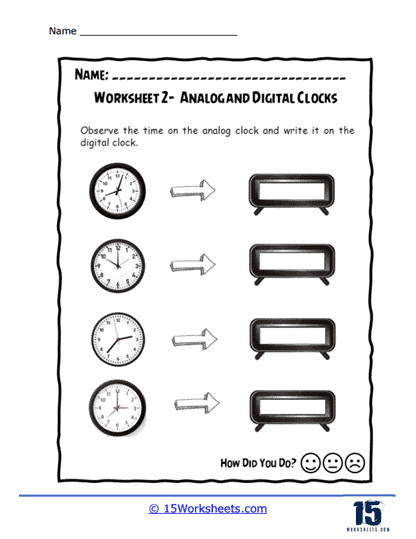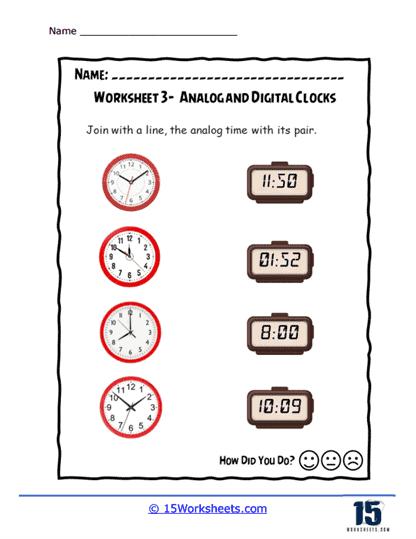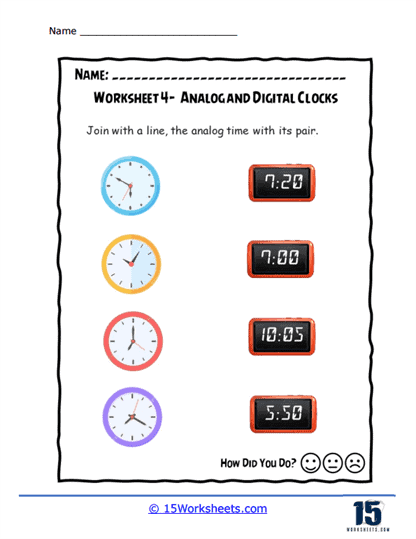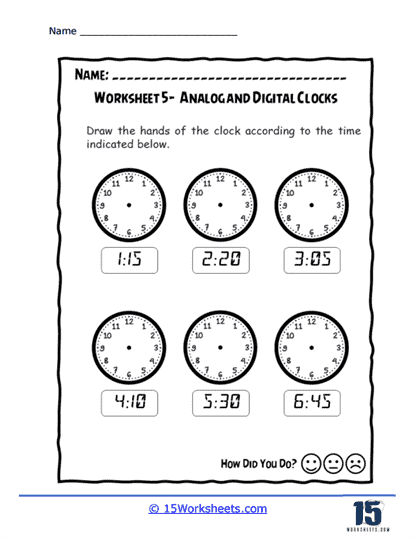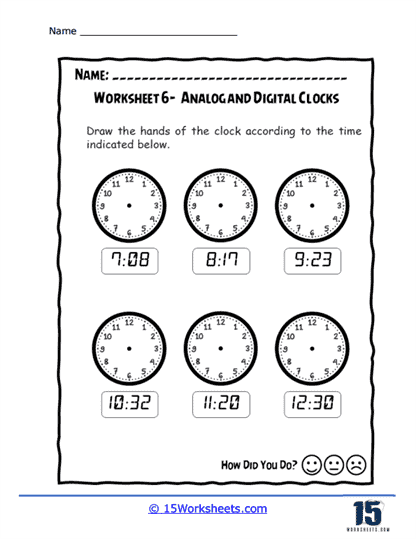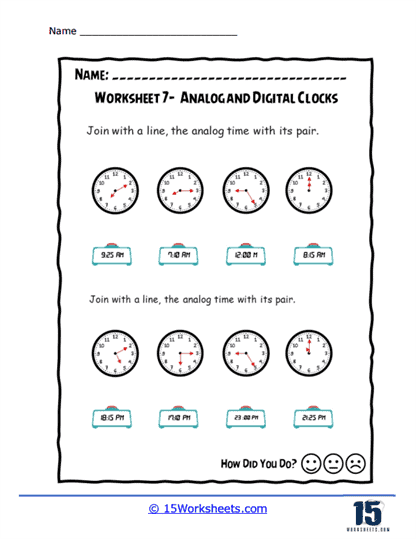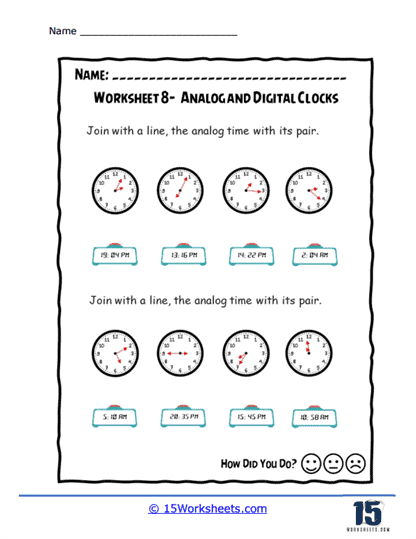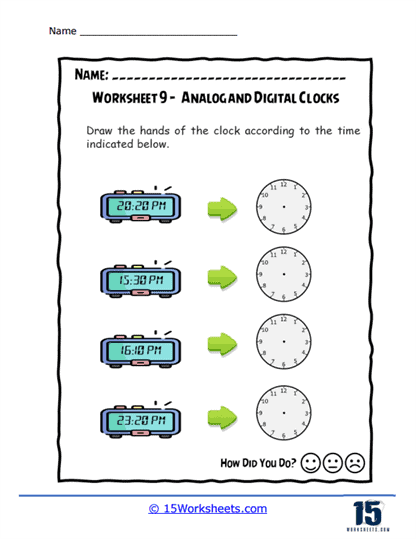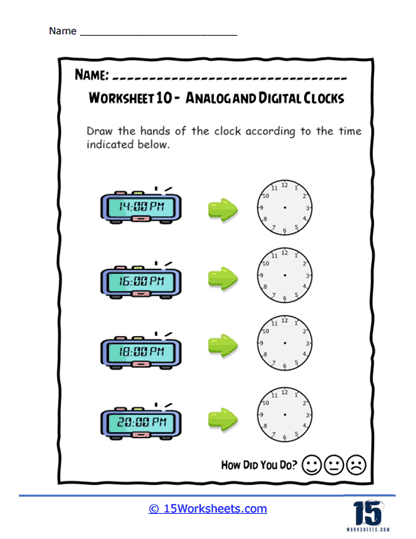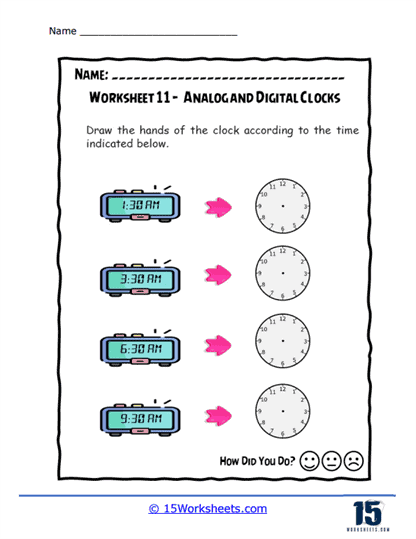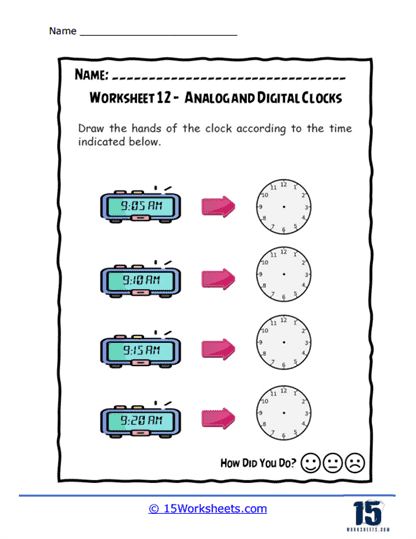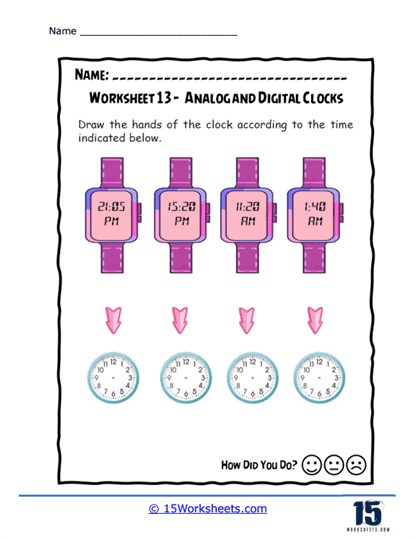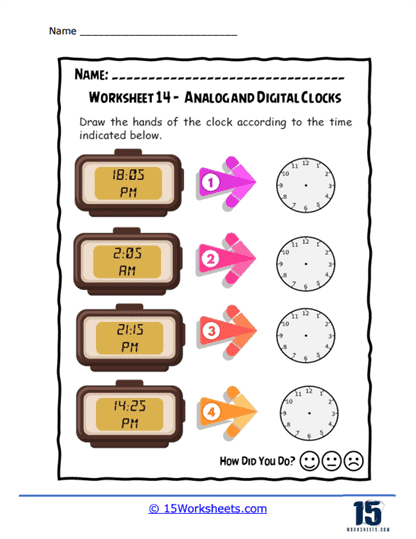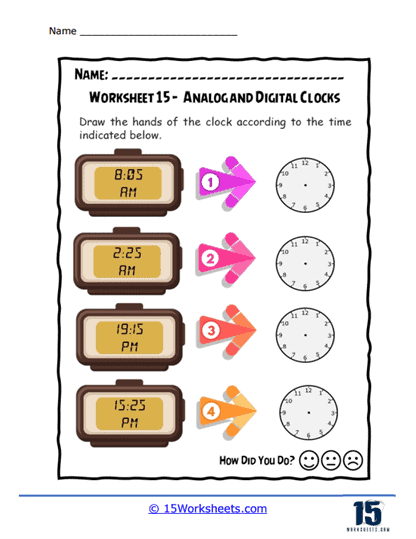Analog and Digital Clocks Worksheets
About These 15 Worksheets
These worksheets will help students learn how to read and interpret both analog and digital clocks. These worksheets are essential in teaching time-telling skills, which are fundamental for managing daily activities and understanding the passage of time. By engaging with these worksheets, students can improve their ability to convert between analog and digital formats, a skill that is increasingly important in our technology-driven world.
These worksheets typically present a variety of exercises that require students to either read the time from analog clocks and write it in digital format, or vice versa. They might also include activities that involve matching times, drawing hands on analog clocks to show a given digital time, and solving word problems related to time. The goal is to provide a comprehensive understanding of how time is represented and used in different contexts.
Mathematical Skills Explored
These worksheets explore a variety of math skills that are crucial for students to develop a comprehensive understanding of telling time and its applications. These worksheets cover a broad range of topics, including number recognition, understanding time intervals, and conversion between different time formats.
One fundamental skill explored in these worksheets is number recognition and sequencing. On an analog clock, students need to identify the numbers 1 through 12 and understand their sequential order around the clock face. This basic skill lays the foundation for more complex time-telling tasks. In the context of digital clocks, students learn to recognize numbers up to 59, as digital time often includes minutes expressed in two-digit form. This practice reinforces their ability to read and interpret numbers quickly and accurately.
Another critical skill is understanding time intervals and the concept of elapsed time. Worksheets often include exercises where students calculate the amount of time that has passed between two given points or determine what time it will be after a certain number of minutes or hours. This involves both addition and subtraction, enhancing students’ arithmetic skills. For example, if a worksheet asks what time it will be one hour and 15 minutes after 3:45, students must perform the necessary calculations to arrive at the correct answer.
These worksheets teach students to convert between analog and digital time formats. This skill is essential for ensuring students can interpret time no matter how it is presented. For instance, they may be given a time in digital format, such as 2:30, and asked to draw the corresponding time on an analog clock face, or vice versa. This conversion requires a solid understanding of how the positions of the clock hands relate to the numbers on the clock and how digital time represents those same positions numerically.
Exercises on These Worksheets
These worksheets typically feature a variety of problems and exercises designed to help students master the skill of telling time using both analog and digital formats. These exercises aim to develop a comprehensive understanding of time-telling, ensuring that students can accurately interpret and express time in different ways.
One common type of exercise found on these worksheets is the basic time-telling problem. Students are presented with images of either an analog or digital clock showing a specific time, and they must write the time in the opposite format. For instance, an analog clock showing 3:45 might require students to write “3:45” in digital format, or a digital clock showing “2:30” might require students to draw the hands on an analog clock face. These exercises help students practice converting between analog and digital representations of time.
Another frequent exercise involves matching times. Students are given a list of times in digital format and a list of corresponding times in analog format. Their task is to draw lines connecting the matching pairs. This type of activity reinforces the relationship between the two formats and helps students become more comfortable interpreting time regardless of its presentation.
Worksheets may also include fill-in-the-blank exercises where students complete sentences with the correct time-related words. For example, a worksheet might have a sentence like “The time is half past ____,” and students need to fill in the blank with the correct hour. This type of exercise emphasizes understanding and using time-related vocabulary accurately.
The Benefits Of These Worksheets
Learning how to tell time on both analog and digital clocks offers numerous educational benefits that contribute to a student’s overall development. One significant advantage is the enhancement of mathematical skills. Understanding how to read analog clocks requires recognizing the positions of the hour and minute hands and correlating these positions with numerical values. This process involves basic arithmetic and spatial reasoning, which are foundational skills in mathematics. Similarly, reading digital clocks requires recognizing and interpreting numerical digits, further reinforcing number literacy.
Another benefit is the development of cognitive skills such as attention to detail and time management. Analog clocks require students to pay close attention to the position of the hands, which can vary subtly, to determine the exact time. This attention to detail can improve focus and concentration. Moreover, understanding both types of clocks helps students develop better time management skills. Being able to accurately tell time allows students to plan their activities, manage their schedules, and allocate their time more effectively, which is crucial for academic success and daily life.
Learning to tell time on both analog and digital clocks improves a student’s ability to adapt to different contexts and environments. While digital clocks are prevalent in many modern devices, analog clocks are still widely used in various settings, such as classrooms, public buildings, and traditional watches. Being proficient in reading both types of clocks ensures that students can accurately tell time regardless of the format they encounter, making them more versatile and adaptable.
Real World Application Of This Skill
In the real world, the skill of telling time is essential in numerous aspects of daily life and professional environments. In education, students need to adhere to schedules, meet deadlines, and manage their study time effectively. Being able to tell time accurately helps them stay organized and punctual, which are important traits for academic success. For instance, students must know when their classes start and end, how long they have for breaks, and when assignments are due.
In the workplace, the ability to tell time is equally important. Many jobs require employees to adhere to strict schedules, attend meetings, and meet project deadlines. Professionals who can accurately tell time are better equipped to manage their tasks, meet deadlines, and coordinate with colleagues. For example, a nurse must administer medications at specific times, a factory worker needs to keep track of shifts and production schedules, and a manager must schedule meetings and manage time effectively.
In everyday life, telling time is crucial for maintaining a routine and managing personal responsibilities. Whether it’s waking up on time, catching a bus, cooking meals, or attending appointments, being able to tell time accurately is essential for staying organized and punctual. This skill also helps individuals plan their leisure activities and balance their work-life commitments, contributing to a more structured and stress-free lifestyle.


